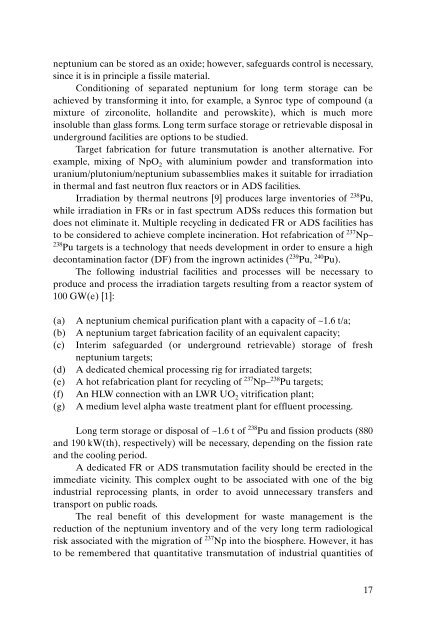TRS435_web
TRS435_web
TRS435_web
You also want an ePaper? Increase the reach of your titles
YUMPU automatically turns print PDFs into web optimized ePapers that Google loves.
neptunium can be stored as an oxide; however, safeguards control is necessary,<br />
since it is in principle a fissile material.<br />
Conditioning of separated neptunium for long term storage can be<br />
achieved by transforming it into, for example, a Synroc type of compound (a<br />
mixture of zirconolite, hollandite and perowskite), which is much more<br />
insoluble than glass forms. Long term surface storage or retrievable disposal in<br />
underground facilities are options to be studied.<br />
Target fabrication for future transmutation is another alternative. For<br />
example, mixing of NpO 2 with aluminium powder and transformation into<br />
uranium/plutonium/neptunium subassemblies makes it suitable for irradiation<br />
in thermal and fast neutron flux reactors or in ADS facilities.<br />
Irradiation by thermal neutrons [9] produces large inventories of 238 Pu,<br />
while irradiation in FRs or in fast spectrum ADSs reduces this formation but<br />
does not eliminate it. Multiple recycling in dedicated FR or ADS facilities has<br />
to be considered to achieve complete incineration. Hot refabrication of 237 Np–<br />
238 Pu targets is a technology that needs development in order to ensure a high<br />
decontamination factor (DF) from the ingrown actinides ( 239 Pu, 240 Pu).<br />
The following industrial facilities and processes will be necessary to<br />
produce and process the irradiation targets resulting from a reactor system of<br />
100 GW(e) [1]:<br />
(a)<br />
(b)<br />
(c)<br />
(d)<br />
(e)<br />
(f)<br />
(g)<br />
A neptunium chemical purification plant with a capacity of ~1.6 t/a;<br />
A neptunium target fabrication facility of an equivalent capacity;<br />
Interim safeguarded (or underground retrievable) storage of fresh<br />
neptunium targets;<br />
A dedicated chemical processing rig for irradiated targets;<br />
A hot refabrication plant for recycling of 237 Np– 238 Pu targets;<br />
An HLW connection with an LWR UO 2 vitrification plant;<br />
A medium level alpha waste treatment plant for effluent processing.<br />
Long term storage or disposal of ~1.6 t of 238 Pu and fission products (880<br />
and 190 kW(th), respectively) will be necessary, depending on the fission rate<br />
and the cooling period.<br />
A dedicated FR or ADS transmutation facility should be erected in the<br />
immediate vicinity. This complex ought to be associated with one of the big<br />
industrial reprocessing plants, in order to avoid unnecessary transfers and<br />
transport on public roads.<br />
The real benefit of this development for waste management is the<br />
reduction of the neptunium inventory and of the very long term radiological<br />
risk associated with the migration of 237 Np into the biosphere. However, it has<br />
to be remembered that quantitative transmutation of industrial quantities of<br />
17


